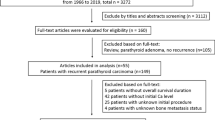Abstract
Background
The incidence of parathyroid carcinoma is reported to be rising. There is minimal data on prognostic variables associated with cancer-specific survival. The objectives of this study were to evaluate the trends in incidence and assess prognostic factors.
Methods
A retrospective review of the SEER database between 1973 and 2014 was performed, identifying 520 patients with parathyroid carcinoma. Population-adjusted incidence rates were calculated in 4-year intervals. A Cochrane-Armitage test was performed to analyze changes in trend in incidence, tumor size, and extent of disease. Age, year of diagnosis, race, gender, extent of disease, surgical resection, treatment with radiation, tumor size, and lymph node status were assessed using Mantel-Cox log rank test. Multivariate analysis was performed by Cox regression analysis.
Results
The incidence of parathyroid carcinoma has been increasing since 1974 from 2 to 11 cases per 10 million people but has since stabilized at 11 cases per 10 million people since 2001. The increasing incidence was attributed to locoregional disease and tumor size < 3 cm. The presence of metastatic disease [hazard ratio (HR) 111.4, 95% confidence interval (CI) 20.6–601.8, p < 0.0001) and tumor size > 3 cm (HR 5.6, 95% CI 1.5–21.2, p = 0.011] were associated with worse cancer-specific survival by univariate and multivariate analyses.
Conclusions
The incidence of parathyroid carcinoma has remained stable over the past decade. Tumor size < 3 cm and regional disease have increased in incidence. Patients with metastatic disease and tumors > 3 cm have worse cancer-specific survival. These findings can be incorporated in the development of a staging system for parathyroid carcinoma.



Similar content being viewed by others
References
Sadler C, Gow KW, Beierle EA, et al. Parathyroid carcinoma in more than 1,000 patients: a population-level analysis. Surgery. 2014;156(6):1622–30.
Owen RP, Silver CE, Pellitteri PK, et al. Parathyroid carcinoma: a review. Head Neck. 2011;33:429–36.
National Cancer Institute (2017). Parathyroid Cancer Treatment. https://www.cancer.gov/types/parathyroid/hp/parathyroid-treatment-pdq. Accessed 5 Feb 2017.
Wei CH, Harari A. Parathyroid carcinoma: update and guidelines for management. Curr Treat Options Oncol. 2012;13(1):11–23.
Hara H, Igarashi A, Yano Y, et al. Ultrasonographic features of parathyroid carcinoma. Endocr J. 2001;48(2):213–7.
Lee PK, Jarosek SL, Virnig BA, Evasovich M, Tuttle TM. Trends in the incidence and treatment of parathyroid cancer in the United States. Cancer 2007;109(9):1736–41.
Asare EA, Sturgeon C, Winchester DJ, et al. Parathyroid carcinoma: an update on treatment outcomes and prognostic factors from The National Cancer Data Base (NCDB). Ann Surg Oncol. 2015;22(12):3990–5.
Wilhelm SM, Wang TS, Ruan DT, et al. The American Association of Endocrine Surgeons guidelines for definitive management of primary hyperparathyroidism. JAMA Surg. 2016;151(10):959–68.
Bilezikian JP, Khan AA, Potts JT, et al. Guidelines for the management of asymptomatic primary hyperparathyroidism: summary statement from the Third International Workshop. J Clin Endocrinol Metab. 2009;94(2):335–9.
Harari A, Waring A, Fernandez-Ranvier G, et al. Parathyroid carcinoma: a 43-year outcome and survival analysis. J Clin Endocrinol Metab. 2011;96(12):3679–86.
Hsu KT, Sippel RS, Chen H, Schneider DF. Is central lymph node dissection necessary for parathyroid carcinoma? Surgery. 2014;156(6):1336–41.
Villar-del-Moral J, Jimenez-Garcia A, Salvador-Egea P, et al. Prognostic factors and staging systems in parathyroid carcinoma: a multicenter cohort study. Surgery. 2014;156(5):1132–44.
Hundahl SA, Fleming ID, Fremgen AM, Menck HR. Two hundred eighty-six cases of parathyroid carcinoma treated in the U.S. between 1985–1995: a National Cancer Data Base Report. Cancer. 1999;86:538–44.
Young S, Wu JX, Li N, Yeh MW, Livhits MJ. More extensive surgery may not improve survival over parathyroidectomy alone in parathyroid carcinoma. Ann Surg Oncol. 2016;23(9):2898–904.
Funding
This research was supported by the Intramural Research Program of the Center for Cancer Research, National Cancer Institute, National Institutes of Health.
Author information
Authors and Affiliations
Corresponding author
Rights and permissions
About this article
Cite this article
Lo, W.M., Good, M.L., Nilubol, N. et al. Tumor Size and Presence of Metastatic Disease at Diagnosis are Associated with Disease-Specific Survival in Parathyroid Carcinoma. Ann Surg Oncol 25, 2535–2540 (2018). https://doi.org/10.1245/s10434-018-6559-6
Received:
Published:
Issue Date:
DOI: https://doi.org/10.1245/s10434-018-6559-6




